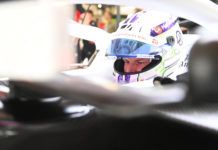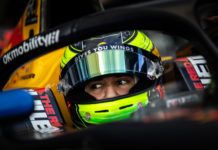AlphaTauri Technical Director Jody Egginton discusses changes to the team’s AT02, and how they’ve allocated their resources in development.
The team launched their 2021 F1 car last week, on which new regulations had ostensibly had great influence. As mandated, a simplified and narrowed floor can be seen, among other alterations made in reaction to the new regulations. Egginton, though, says that their changes go ‘far beyond’ those prompted by regulatory amendments, and impact ‘nearly all aerodynamic surfaces’.
Egginton also says the team will continue to make adjustments to their car in the coming season, dividing resources between the current campaign and that which they will run in 2022, with a new generation of cars. “With the changes to the aero regulations targeting a reduction in downforce, we have been presented with a number of changes we have got to make to the floor, the diffuser and rear brake ducts and this has required a lot of work to re-optimise around these changes,” he began.
“The work which has been undertaken to develop our car for 2021 goes far beyond compliance with regulation changes and has involved changes to nearly all aero surfaces and also development and repackaging large parts of the car, which are hidden, in order to achieve these changes.
“We have spent a lot of time working to recover the aero losses as a result of the regulation changes, while also focusing on increasing and improving the cars aerodynamic operating window. This activity will continue into the season, with the split of resource between the 2021 and 2022 projects reviewed and adjusted as required to maximise the potential of both projects,” Egginton promised.
With Pirelli changing tyre constructions heading into 2021, AlphaTauri also had new rubber to contend with in the development of their AT02. But Egginton says this was not troubling for the team, who tested with the tyres last year and gained knowledge of the construction. “We have tested with these tyres and we believe we have a good understanding of how they operate compared to the 2020 tyre,” he said.
The Brit says that the team elected to carry over their safety cell from 2020’s AT01, aiming to conserve development tokens, of which teams were allotted only two. Egginton considers the AT01 the best car produced out of Faenza, though he says that 2019’s STR14 – developed by Toro Rosso – remains a contender.
“I really believe the AT01 was the best car to be produced by the team,” said Egginton. “The STR14 was not a bad car but the AT01 developed very well through the season and its performance was a credit to the hard work of everybody involved in the project.
“For 2021 major changes to the car require the use of ‘tokens’ and each team is limited to just 2 tokens, as such we have elected to carryover the Safety Cell. We believe the chassis and power unit provides a good baseline, so we are happy to have spent our tokens elsewhere for 2021,” said Egginton.
AlphaTauri instead decided to spend their development tokens on the front end of the car, upgrading their steering assembly to 2021 specification, and making changes to the nose. Updating the front end meant keeping 2020’s rear-end components, despite the option to re-equip the car with Red Bull’s 2021 parts.
“The use of Red Bull Technologies supplied gearbox, rear suspension and some front suspension components is now in its third year for us but for 2021 we have elected to continue with the same rear suspension & gearbox design as we used in 2020,” Egginton said.
“We’ve elected to use our two tokens for a new nose and also redesigned the outboard front suspension, as a result of this we have elected to update some Red Bull Technologies supplied steering components to 2020 specification, as permitted by the Technical Regulations,” he adds.
In developing the AT02, AlphaTauri have also found themselves challenged by restricted wind tunnel and Computer Fluid Dynamics (CFD) testing. Though the severity of the limit is decided by championship position, Egginton says this is of little importance as their allowed testing time is a relative zero point around which others exist.
“You are subject to this sliding scale of how many aero runs you can complete,” Egginton began. “Finishing seventh last year means we are at a notional zero point, so that anyone who finished behind us gets more time and those ahead of us get less.
“We support this system and believe it’s a sensible step in trying to bring the field closer together – it pushes teams to be as efficient as possible with each and every aero run which in turn is pushing us to find ways to extract as much information as we can from each run and develop our methodologies to try and extract even more going forwards,” he says.
Here’s Honda on what changes they have for its power unit
Here’s the 2021 AlphaTauri livery
Here’s Christian Horner on steps with Honda beyond 2021



















